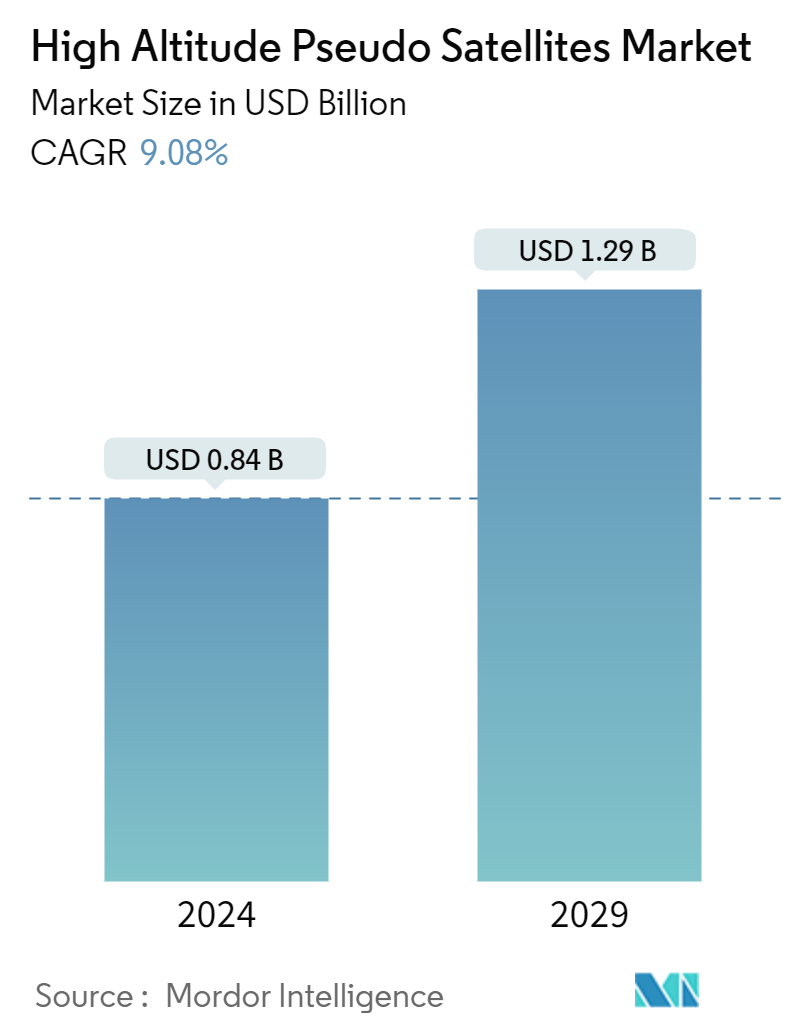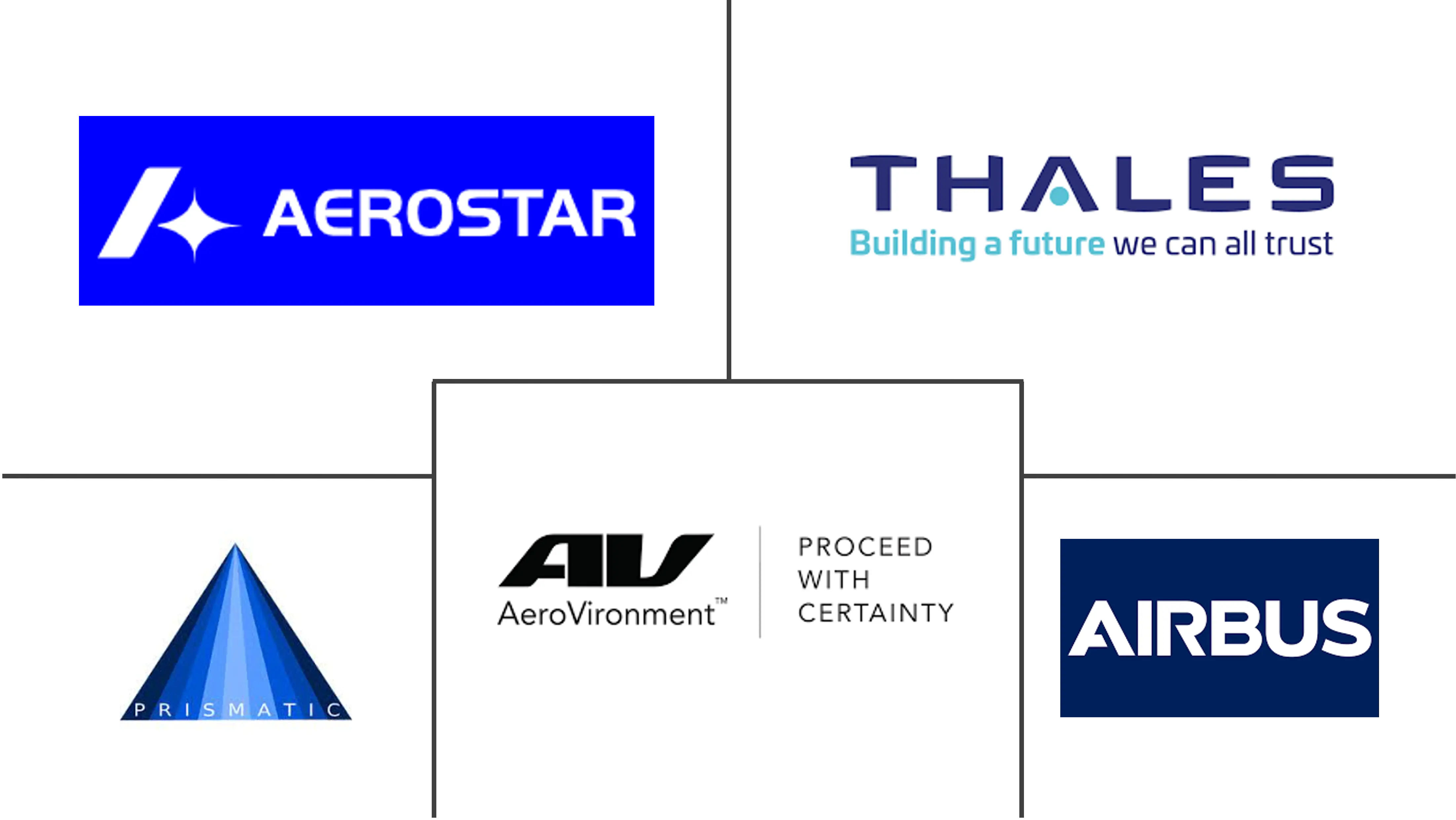Market Size of High Altitude Pseudo Satellites Industry

| Study Period | 2019 - 2029 |
| Market Size (2024) | USD 0.84 Billion |
| Market Size (2029) | USD 1.29 Billion |
| CAGR (2024 - 2029) | 9.08 % |
| Fastest Growing Market | Asia Pacific |
| Largest Market | Asia Pacific |
Major Players
*Disclaimer: Major Players sorted in no particular order |
High Altitude Pseudo Satellites Market Analysis
The High Altitude Pseudo Satellites Market size is estimated at USD 0.84 billion in 2024, and is expected to reach USD 1.29 billion by 2029, growing at a CAGR of 9.08% during the forecast period (2024-2029).
High-altitude pseudo-satellite (HAPS) blends the strengths of terrestrial and satellite communication systems. They overcome the limitations of traditional satellites, offering voice, video, and broadband services with better cost-to-performance ratios. Telecommunication providers increasingly turn to HAPS to meet the rising demand for high-capacity wireless services, especially in remote areas lacking robust ground-based networks.
While HAPS is cost-effective to build and operate, its endurance poses a challenge. Platforms like unmanned aerial vehicles (UAVs) are integrating electric propulsion systems to address this. This shift has spurred significant R&D investments in developing robust battery systems and high-charge density solar panels, enhancing the platforms' endurance and making them more appealing to telecom and emergency service providers.
As an emerging technology, high-altitude pseudo-satellites are poised to revolutionize the remote sensing and surveillance market. They present both disruptive and complementary applications compared to services provided by satellites, terrestrial infrastructures, and remotely piloted aircraft systems (RPAS), all at a notably lower cost.
Operating in the stratosphere, where air density is just 7% of that at sea level, these pseudo-satellites face unique challenges. For instance, to sustain flight, fixed-wing UAVs may need larger wing areas, while airships or balloons might require increased volume. Designers must opt for advanced, lightweight materials to meet weight specifications. Google's Project Loon, for example, explores materials like metalized mylar, biaxially-oriented polyethylene terephthalate (BoPET), and flexible chloroprene for its stratospheric balloons. Similarly, Facebook utilized T700 carbon fiber in Aquila's prototype. As HAPS models evolve, the industry is set to focus more on lightweight material R&D in the coming years.
High Altitude Pseudo Satellites Industry Segmentation
Pseudo-satellites, potential substitutes for traditional satellites, operate at stratospheric altitudes, typically between 10 to 30 miles above sea level. These platforms are geostationary, leading to localized service provision. The market study focuses on the R&D of various pseudo-satellite platforms, production by market players, and deployments within the study period. The estimates exclude sales and replacements of individual pseudo-satellite components.
The high-altitude pseudo-satellites market is segmented by technology and geography. By technology, the market is segmented into stratospheric balloons, airships, and UAVs. The report covers the market sizes and forecasts in major countries across different regions. For each segment, the market sizes and forecasts are provided in terms of value (USD).
| Technology | |
| Stratospheric Balloons | |
| Airships | |
| UAVs |
| Geography | |||||||
| |||||||
| |||||||
| |||||||
| |||||||
|
High Altitude Pseudo Satellites Market Size Summary
The high-altitude pseudo-satellite (HAPS) market is experiencing significant growth, driven by the increasing demand for high-capacity wireless services, particularly in remote areas with limited ground-based network coverage. HAPS systems, which operate in the stratospheric layer of the Earth's atmosphere, combine the advantages of terrestrial and satellite-based communication systems, offering more economical pricing and performance margins compared to traditional geostationary satellites. This has led to their growing adoption by telecommunications service providers. Despite their cost-effectiveness, HAPS platforms face challenges such as endurance limitations and operational difficulties due to the thin air at high altitudes. To address these issues, substantial investments are being made in research and development to enhance the endurance of HAPS through advanced battery systems and high-charge density solar panels. The airship segment, in particular, is expected to dominate the market due to its ability to cover large areas quickly and effectively, making it a preferred choice for communication and surveillance missions.
The Asia-Pacific region is witnessing a high adoption rate of HAPS, driven by the lack of critical infrastructure in remote locations and the need for cost-effective broadband services. Governments in this region are actively testing HAPS for various applications, including search and rescue missions, disaster relief, and environmental monitoring. The market is moderately consolidated and highly competitive, with key players like AeroVironment, Inc., Airbus SE, and THALES competing based on technological offerings and integration capabilities. The competitive landscape is expected to intensify with increased product extensions and technological innovations. Recent developments, such as the successful test flights of solar-powered drones and partnerships for exploring HAPS-based connectivity services, highlight the ongoing advancements in the industry. These efforts, coupled with favorable adoption trends, are anticipated to drive the growth of the HAPS market in the coming years.
High Altitude Pseudo Satellites Market Size - Table of Contents
-
1. MARKET DYNAMICS
-
1.1 Market Overview
-
1.2 Market Drivers
-
1.3 Market Restraints
-
1.4 Industry Attractiveness - Porter's Five Forces Analysis
-
1.4.1 Bargaining Power of Suppliers
-
1.4.2 Bargaining Power of Buyers/Consumers
-
1.4.3 Threat of New Entrants
-
1.4.4 Threat of Substitute Products
-
1.4.5 Intensity of Competitive Rivalry
-
-
-
2. MARKET SEGMENTATION
-
2.1 Technology
-
2.1.1 Stratospheric Balloons
-
2.1.2 Airships
-
2.1.3 UAVs
-
-
2.2 Geography
-
2.2.1 North America
-
2.2.1.1 United States
-
2.2.1.2 Canada
-
-
2.2.2 Europe
-
2.2.2.1 United Kingdom
-
2.2.2.2 France
-
2.2.2.3 Germany
-
2.2.2.4 Italy
-
2.2.2.5 Rest of Europe
-
-
2.2.3 Asia-Pacific
-
2.2.3.1 China
-
2.2.3.2 India
-
2.2.3.3 Japan
-
2.2.3.4 South Korea
-
2.2.3.5 Rest of Asia-Pacific
-
-
2.2.4 Latin America
-
2.2.4.1 Brazil
-
2.2.4.2 Mexico
-
-
2.2.5 Middle East and Africa
-
2.2.5.1 Saudi Arabia
-
2.2.5.2 United Arab Emirates
-
2.2.5.3 Turkey
-
2.2.5.4 South Africa
-
2.2.5.5 Rest of Middle East and Africa
-
-
-
High Altitude Pseudo Satellites Market Size FAQs
How big is the High Altitude Pseudo Satellites Market?
The High Altitude Pseudo Satellites Market size is expected to reach USD 0.84 billion in 2024 and grow at a CAGR of 9.08% to reach USD 1.29 billion by 2029.
What is the current High Altitude Pseudo Satellites Market size?
In 2024, the High Altitude Pseudo Satellites Market size is expected to reach USD 0.84 billion.

